






We’ve gotten this far without burning down...why stop now?
By Joshua Chang
We’ve reached the starting line of another school year. The Eyeopener has returned to Toronto Metropolitan University’s (TMU) campus from the summer’s warm embrace, and with it, thousands of students with eager eyes and open ears. Just like that, we’re back again. I entered last year as a brand new editor with The Eye and a fourth-year student. Having begun my university career online back in 2020, I was optimistic that The Eye would soon recover from years spent watching the COVID-19 pandemic drain away accessibility to its readers. However, as the seasons changed, it became clear there would be that and much more to focus our attention on.
All throughout last year, major changes struck TMU and pushed everyone to their feet— including The Eye. We found ourselves face-to-face with drastic developments in news accessibility, global warfare and the many updates within our university—all taking a serious toll on our students, staff and communities. We pursued these stories with the main priority of telling them with integrity, empathy and intelligence.
Still, I knew that despite everyone’s best efforts to push forward, there would be dark days ahead.

Editor-in-Chief
Joshua “Froshua” Chang
News Editors
Jasmine “LSAT” Makar
Jerry “CC” Zhang
Lillie “Florida!!!” Coussée
Arts & Culture Editor
Anastasia “Starlet” Blosser
Business & Technology Editor
Anthony “Master Pitcher” Lippa-Hardy
Communities Editor
Khushy “Globe Queen” Vashisht
Features Editor
Nalyn “AEST” Tindall
Fun & Satire Editor
Sarah “Brat Semester” Grishpul
Sports Editors
Daniel “City > Arsenal” Carrero
Mitchell “Got His Sandwich” Fox
Production Editors
Jake “Champagne” MacAndrew
John “Fashionista” Vo
Photo Editors
LeBron “Flammekueche” Pryce
Amongst all of this, The Eye’s promises to you, our readers, stay true. As always, we will strive to keep the university body well-informed on all things TMU related, provide the most accurate coverage and pursue our goal of doing the most good and the least harm in our work.
This isn’t to say there haven’t been obstacles along the way. As Bill C-18, also known as the Online News Act, continues to restrict access to Canadian news on social media in the country, The Eye has made it a goal to increase our online presence to accommodate TMU students and staff in response to the change.
Since the act received royal assent in June 2023, Canadian news outlets have lost 85 per cent of their engagement on Meta-owned platforms like Instagram and Facebook according to new research published by The Media Ecosystem Observatory. To make matters more concerning, less than a quarter of Canadians are even aware of the ban—over a year after it was implemented. This makes it important now more than ever for us to make our content more visible and accessible to the public.
In light of this, a brand new role, the digital producer, has been introduced to our masthead to dedicate special attention towards the quantity and quality of our online content.
We hope this change will ensure consistent news updates on our social media platforms, provide more efficient access to our coverage and protect viewers from misinformation.
In stride with last year’s publication calendar, The Eye will be maintaining its bi-weekly print schedule to focus on our online presence and protect our readership as it becomes more difficult to access news online and less common to obtain it in print. Additionally, this decision will allow us to preserve the quality of our reduced print copies and commit more resources into keeping them accessible and of high quality.
While our bi-weekly circulation doesn’t ensure every story gets laid out on paper, each one is still just as equally important to cover. We will continue to keep the university accountable for its student resources, health and safety procedures and additional efforts to increase security on campus. We will also keep an eye out for progressions in our community’s continuous developments and those relevant to it, such as the anticipated renaming of Yonge-Dundas Square to Sankofa Square.
All of this to say, our reporting will stretch as far as necessary to shed light on as many impactful university stories as possible. Our hope is to represent the student body in every
section and amplify their voices in every story. Whether it be through a protest for change or a riveting game down at the Mattamy Athletic Centre, you can bet we’ll be there.
The Eye recognizes the changes affecting all of us at TMU. For better or for worse, whether we like it or not, this will continue to be what pushes us forward and reminds us why we’re still around, fighting for a better future. As your university newspaper, run by students and for students, we promise to never forget this. We are and will always be represented by you and will work tirelessly to maximize the wellbeing of our community as a result.
To all the brand new students who will undoubtedly be frequenting Balzac’s and getting lost in Kerr Hall for the first time—welcome! And to everyone else entering another era of their life here, you can rest a bit easier knowing this ain’t your first rodeo. There’s still much to do and we’re proud to have you tag along as we find our way in this whirlwind called the present. So as you bravely enter the Fall 2024 semester, know this: if you’re ever feeling like a fish out of water, don’t worry. I swear we’re right there in the sand next to you.
Besides, we’ve gotten this far without burning down…why stop now?
Saif-Ullah “Fishy” Khan
Sammy “Home Run” Kogan
Media Editors
Divine “ACTION!” Amayo Konnor “Euro-vacay” Killoran
Digital Producer
Lily “First Ever” Han
Circulation Manager
Sherwin “Circu-slay-tion” Karimpoor
General Manager
Liane “We’re So Back” McLarty
Contributors
Vanessa “Adobe Wizard” Kauk
Jacob “Shoe Sleuth” Marion
Ella “Wilderness Wayfinder” Miller
Adriana “Knit-picky” Fallico
Nicolette “Nikki” Williams
Daniel “3 Months Pregnant” Chirichella
Ava “@ Oakham” Surbek
Jahrell “Fun Sized” Teodoro
Khaneil “Number 1” Cameron
Jessica “Meow” Lila-Grant
Samantha “The Proposal” Riga
Negin “Wasabi” Khodayari Ilyas “Étoile” Hussein
Daniella “Vegan Bakery” Lopez
Shaki “Hacker Voice” Sutharsan
Madeline “Loves WP!” Liao
Tyler “IOU Dinner” Griffin
Jacob “Iced Americano” Dubé
Sarah “Phone Interview” Krichel
Address
55 Gould Street, Toronto, ON, M5B 15B, Suite 207
By Jasmine Makar
Incoming first-year students can find community and friends through a multitude of social activities hosted on campus. Between student groups and course unions, there are plenty of opportunities for students to socialize and make the most of the university experience.
Currently, 100 student groups are registered with the Toronto Metropolitan Students’ Union (TMSU), not including individual course unions and student societies. Course unions represent a specific program’s student population, typically hosting fun events to engage students.
President of the Society of the Creative School and fourthyear professional communication student Ava Ruscillo emphasized the importance and value of extracurriculars based on her own experience.
“A lot of people, since they’re commuters, just go to school and go home. But to really immerse yourself in the ecosystem of our school, I think it’s important that you do things that you’re a little afraid of,” she said.
Ruscillo also told The Eyeopener in a phone interview that after the pandemic, during her
second year at Toronto Metropolitan University (TMU), she wanted to branch out to find extracurriculars outside of her school work.
“Something compelled me to want to join something on campus, whether it be a club or another type of student group, just something that I could build a community with,” said Ruscillo.
With the significant transition from high school to university, TMU students are finding that it can be difficult to make friends and other connections on campus.
“It’s important that you do things that you’re a little afraid of”
Third-year business technology management student Luis Alitagtag highlights how student groups and social activities can foster lasting friendships and valuable personal and professional connections.
“I’ve met some of my closest friends through extracurriculars and I have been exposed to great opportunities. I would highly recommend it,” said Alitagtag, the at-large director of the Ted Rogers Student Society (TRSS) and the vice-president of mar-
keting for the Toronto Metropolitan Consulting Association.
He shared his experience as a commuter student from Markham, Ont., noting how transportation schedules can make it challenging to participate in social activities.
“In a ‘dorm school,’ you’re really close with your friends and after class, you could just hang out with them very willingly,” said Alitagtag. “But as a commuter, you have to worry about things like, ‘Oh, I have to make my train’ or ‘Oh, I can’t be out too late.’ So you definitely have to put some effort into establishing and fostering those social relationships.”
According to a 2019 study by StudentMoveTO, 77 per cent of TMU students commute to school. This large commuter population creates a distinct cultural dynamic at TMU compared to other universities, mainly because of its unique location in the core of Toronto.
Aside from the large commuter population at TMU, there are over 4,000 international students, according to TMU’s admissions web page, who face unique challenges in socializing and finding their place on campus. “It has been

daunting for me—especially being an international student— but you have to join a couple of student groups so that you can have the opportunity to meet new people,” said Ananya Malhotra, a third-year international student in the business technology management program.
“It has been daunting for me—especially being an international student”
Malhotra has participated in a number of student groups and clubs throughout her three years at TMU, including the Global Management Student Associa-
tion, TRSS and more while also balancing a part-time job.
“It definitely is more intimidating because we [international students] do not have family here, so we are just trying to find the right people who can help us stay happy, even when we’re missing our family,” she said.
Every student here—regardless of their programs or interests—can find a university community or extracurricular on campus to become a part of by referring to the university’s resources for getting involved— such as the TMSU’s Student Group Directory and TMU’s Recreation page.














By Jerry Zhang
Toronto Metropolitan University (TMU) is primarily located in the Downtown Yonge East neighbourhood. According to the Toronto Police Service’s Major Crime Indicators (MCI) database—which tracks crime reported in each neighbourhood—this area experiences higher crime rates compared to other parts of the city. Downtown Yonge East recorded 641 reported crimes this year, making it the second highest among Toronto’s neighbourhoods.
Given its location, campus security plays a vital role in ensuring the safety of the university community and managing the unique challenges that come with its dynamic urban locale.

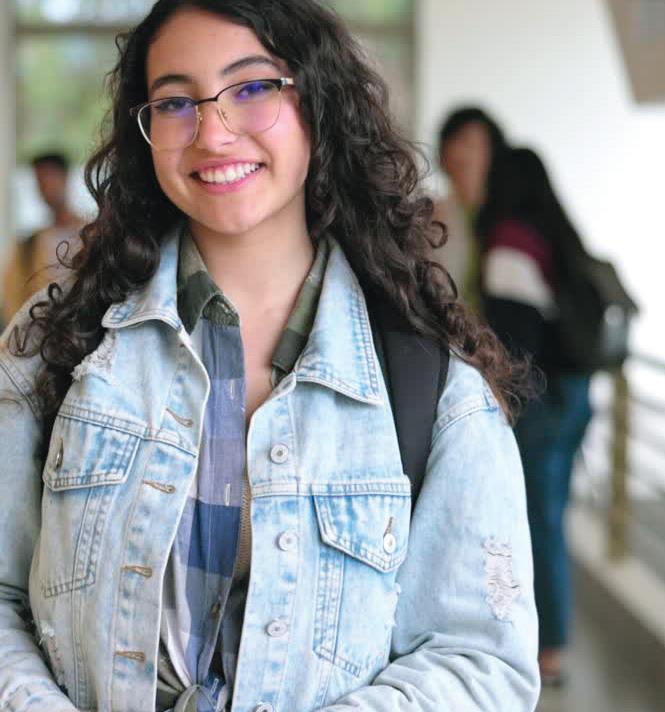

Denise Campbell, executive director of Community Safety and Security, spoke on behalf of the TMU Community Safety and Security to The Eye about the key resources the department offers on campus.
“The university has a broad set
of safety protocols in place to support the safety of our TMU campus community,” she wrote in an emailed response. “Deliver 24/7 coverage of the campus, Respond to emergencies, offer emergency medical assistance, provide WalkSafe escorts, perform safety patrols on foot and by bike.”
In the statement, Campbell encouraged all TMU community members to review a list of five resources to support safety on campus. Published on TMU’s Community Safety and Security page in August 2023, some of these steps include downloading the TMU Safe App, utilizing the university’s Walk Safe Program and ensuring students always have their OneCard on them. The Walk Safe Program is available to all community members through their listed phone number and email. This program offers uniformed security escorts across campus and to nearby subway stations and parking lots off campus.
Read more at theeyeopener.com
By Lillie Coussée
The media scene in Canada has shifted over the past three years. Cuts to newsrooms have become more common according to The Canadian Journalism Foundation.
Bill C-18, also known as the Online News Act, was enacted in 2023. This required big tech companies to compensate media organizations if they wanted to continue to host Canadian news content on their platforms. In response to this bill, Meta-owned platforms blocked all Canadian news content from its sites.
A 2019 report from the Reuters Institute for the Study of Journalism at Oxford University found that the majority of people aged 35-years-old and under almost exclusively use social media to get their news.
As previously reported by The Eyeopener, in 2023 we committed to increasing our digital presence.
Incoming media students at Toronto Metropolitan University (TMU) are dealing with these ongoing changes. Some may be curious or anxious about the future of the Canadian media scene and how they can carve out a place in its changing landscape.
The Eye sat down with the chair of The School of Journalism, Ravindra Mohabeer, to talk about how the school is adapting to these changes and supporting its students.
This interview has been edited for length and clarity.
Q. The media scene in Canada is changing rapidly. How is TMU’s curriculum changing with it?
A. There is an ominous suggestion that print is one thing and physical print certainly has been underdefined. There’s not as much physical print media in the world as there used to be by a long shot, but many of the
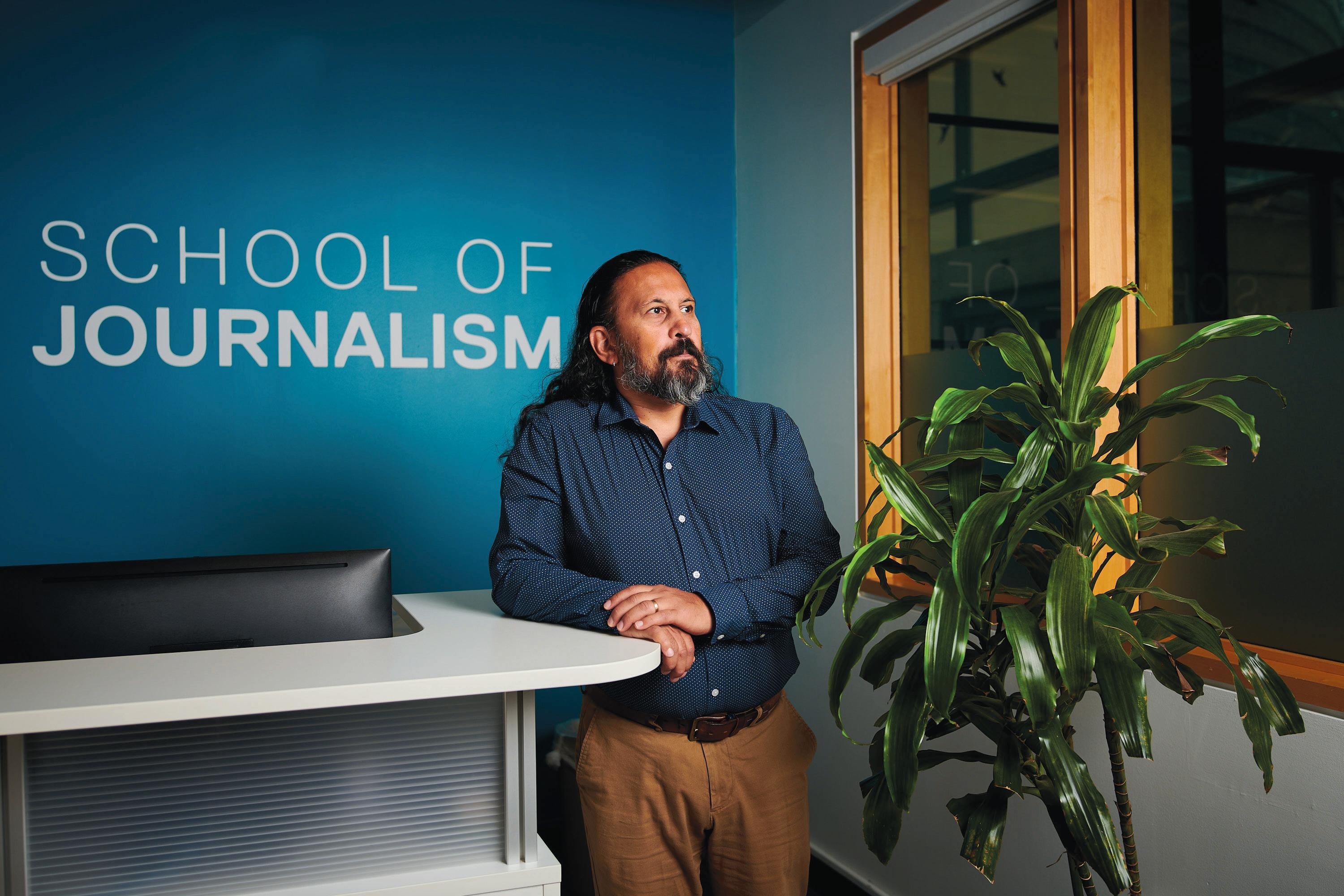
traditional print media organizations have successfully moved to a digital format. They still print, but they print online. We have a digital mindset, not always explicitly and exclusively digital-first but digital is definitely embedded in all of our programming. It was designed to be flexible and [adaptable], despite being deeply rooted in a very long history and tradition of journalism that [used] more traditional formulas.
Q. This year, the program is undergoing a Periodic Program Review (PPR). What does this mean and how it will impact the program?
A. A PPR is mandated for all registered programs in Ontario. Every eight years, we do a comprehensive look at our program and we do a self-study that takes in all aspects [of it]. Then on
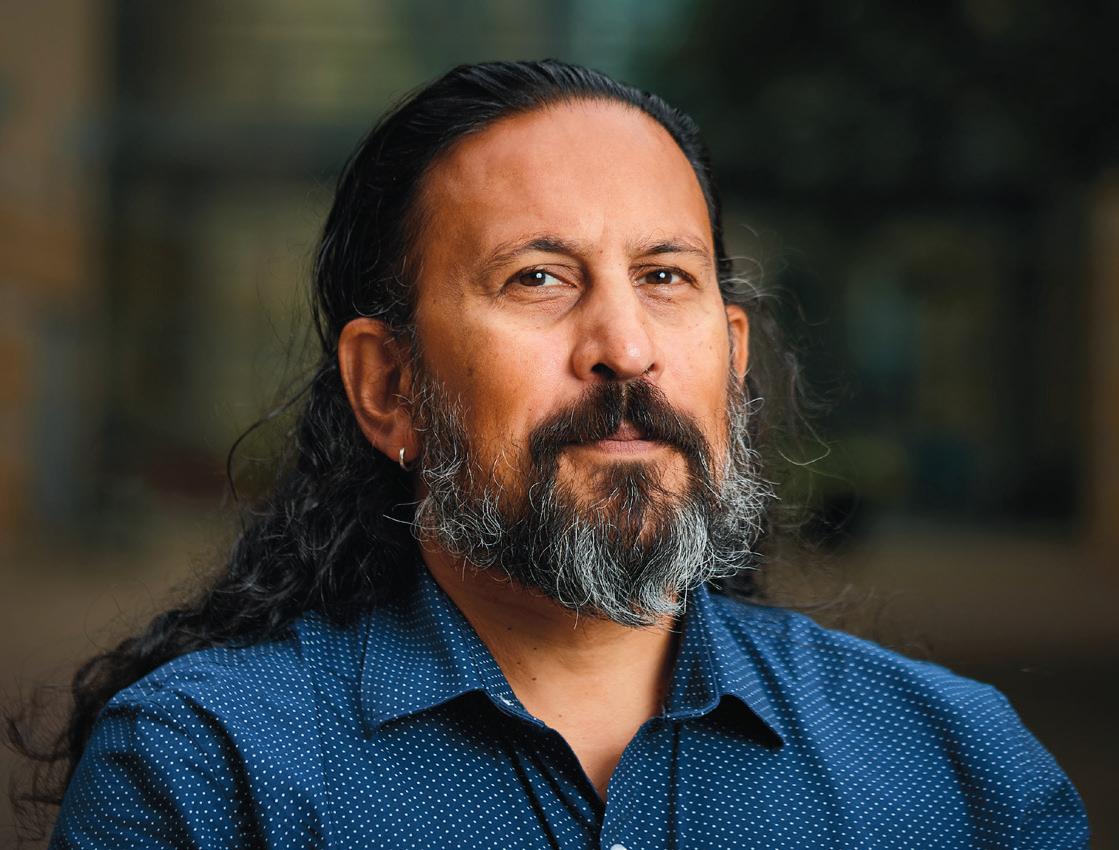
the ground, we look at how all of that plays through the map of what we offer. We’re in the middle of our program review which means that students, faculty, instructors, alumni and employers are consulted and information is gathered from them. Then, we invite two or three external academic experts in journalism to come and take a look at our program and compare it to our self-study.
Our curriculum at the end of the PPR is going to be different than it is today because we’re going to need to make changes. We’re going to be mindful of things like artificial intelligence [and] changing newsrooms.
Across the board, we are going to make sure that rather than [having] the one-off checklist courses for Indigenous, race, gender, sexuality or religion, [we’re going to] make sure those are attributes that people are aware of across the entire curriculum. Then our curriculum may be adjusted fundamentally or the existing courses will be redesigned.
Q. Canadian media outlets have slashed their newsrooms over the past few years. What kind of future do young journalists have in the country’s media scene and how can TMU support them in their careers?
A. We have to be able to recognize where students want to go. We’ve been supporting
a lot more initiatives around innovation in startups. We’ve been doing a lot more to centre and forward the skills of freelance work, portfolio-based work and self-branding in new and emerging technologies such as podcasting and multi-model digital storytelling. Most people who [are] working with us today, who are working in the [journalism] industry, all tell us that being adaptable is almost as important as being really skilled and having a solid portfolio because you have to be able to make adjustments.
What we offer students is the ability to see what they can do if they plan to go towards working in journalism or what they can do with journalism if they plan to go in another direction.
Q. How does The School of Journalism support students from various ethnicities, identities and abilities?
A. Our student body represents Toronto fairly well. About 40 to 50 per cent of our student body are students of colour or students of an equity-seeking group. About 40 per cent of our full-time faculty are people of colour and people from different backgrounds— people who are queer, from different religions and ethnic backgrounds and people from different English orientations.
We have a fairly different representational grouping than may have been historically the
case. And this is not just a surface-level ‘it looks good,’ this is a really robust thing. We’ve also been equally attentive to developing further, greater and more frequent opportunities to listen to students’ experiences as they go along and provide culturally appropriate and culturally relevant support systems. We’ve been trying to increase the representation of the voices that are being centred. We’re not where we need to be, but we’re going in a direction that I think is very positive.
Q. What can students do now to help them succeed in the media industry in Canada?
A. Be curious, do the work and don’t wait for somebody to open the door.
Q. What advice do you have for students coming into The School of Journalism?
A. You just have to be open to what the program is and think about it for yourself. It’s easy to get caught up on what’s not going right. [Students] have time to build towards what [they] want to do. They should be propelled by excitement to be here rather than focus explicitly on one aspect. It’s also naive for me to say thinking about a job in the future doesn’t matter. So plan, plan, plan a path for yourself. Be willing to deal with the surprises that come along the way and explore them as they come up.
By Jacob Marion
Exhibit A: Investigating Crime and Footwear is the newest addition to the Bata Shoe Museum’s (BSM) revolving galleries and aims to educate the public on how footwear plays a role in committing, solving and studying crime throughout history.
Attendees can view a variety of unique and historical shoes pulled from the BSM’s archives as well as pieces from various other museums and collections.
In one glass case, an unassuming pair of men’s black leather dress shoes is displayed to show off a detachable sole with multiple hidden compartments moulded into the rubber heel. Similar shoes have been used for decades to stash anything from drugs to deadly poison to censored material.
In the centre of the room is a pair of dusty wooden clogs that were carved backwards to leave the impression that smugglers had walked in the opposite direction. The specific pair on display were crafted in the mid-1940s by Dutch smugglers who wanted to confuse customs officers at the border between Belgium and the Netherlands.
Even more covert, felt-soled cat-burglar overshoes—on loan from the Paris Police Museum—showed how burglars would slip silencing sandals over their shoes to muffle footsteps during a robbery.
Looking closely, patrons walking through the exhibit might spot assorted shoemaking tools on loan from Toronto Metropolitan University’s (TMU) Fashion Research Collection. Inmates from the Kingston Penitentiary used the set of tools to make shoes as part of their prison sentence. The goods were then sold to government branches like the Royal Canadian Mounted Police. The prison workshop ran throughout the 20th century before protests over the cheap labour and unfair pricing ended the practice.
The concept behind the exhibit came from an extensive online project titled Fabric of Crime, which investigated the use of clothing as weaponry, evidence
and disguise. The research venture was led by Alison Matthews David, a fashion professor at TMU and co-investigated by Elizabeth Semmelhack, the BSM’s director and senior curator.
The pair had worked together on previous exhibitions, so when David asked Semmelhack if she wanted to turn their research into a display for the public, Semmelhack replied, “how could I say no?”
David and Semmelhack travelled to Paris and London together where they explored police archives and delved further into their research.
“We really wanted to think about the importance of footprints in crime and criminal detection,” Semmelhack explained. “But we also wanted to be thoughtful, so we weren’t just thinking about people who were detecting crime but also how certain people are criminalized.”
The idea to research the criminalized led to Exhibit A’s exploration of how biases surrounding race, gender, sexuality and class can impede footwear’s use in forensics and crime-solving.
“Stains, fibres and footprints provide unbiased proof of guilt or innocence”
Near the entrance to the exhibition, excerpts of text spread across the wall explains how French criminologist Edmond Locard believed objects from crime scenes were “more truthful and reliable than people’s testimony...witnesses could forget or lie about events but stains, fibres and footprints provide unbiased proof of guilt or innocence.”
Professor Monica Sauer, who teaches a forensic science course at TMU, says in theory, this should be true.
“Forensics itself, like any hard science, is not biased,” she explained.
“The science can determine the brand, size, footprint inside the shoe, pressure points of toes, but it does not label it with a gender or specific use.”
Exhibit A counterpoints Locard’s principle, stating that while clothing and footwear offer important clues in


criminal cases, they also play a much more complex role in actual crime and who we, often wrongly, have culturally assumed to be a criminal.
Throughout the exhibition, many examples of the biases and inaccurate conclusions that can be drawn from footwear are reflected. Towards the back, a large floor-to-ceiling glass case displays a variety of modern footwear on stark-white podiums. Labelled “Dangerous Glamour,” each of these pieces represent styles either linked to criminal activity or even deemed “fashion crimes” in their own right.
Sometimes, clothing is used to blame victims for the crimes committed against them, suggesting that they may have been “asking for it” by dressing in a promiscuous or counterculture way. A pair of glossy, red patent pump heels could represent how survivors of sexual violence may be blamed for their assault.
The shiny red heels on display in Exhibit A are designed to fit a man’s size 14 foot and serve as a reminder of how gender normalities were policed in Europe and North America. In 1947, an Eaton’s department store employee and part-time drag queen named John Herbert was attacked and almost mugged on the streets of Toronto.
Despite being the victim of the crime, he was sent to a reformatory because he was wearing “female-coded dress” at the time of the robbery.
On an adjacent podium is a pair of uncharacteristically pristine red combat boots from the famous English brand, Dr. Martens. Often associated with punk movements, the working class and even white nationalism, wearing a pair of these combat boots can label their wearer as a delinquent even if the brand has become more mainstream.
Other pairs of shoes perpetuate stereotypes that harm racialized communities. In a May 1990 issue of Sports Illustrated, the cover story “Your Sneakers or Your Life” suggested race was a significant component of armed robberies over expensive sneakers.
The featured artwork depicted a young Black man pressing a gun to the back of another young Black man while
stealing his Air Jordans. The article blamed basketball player Michael Jordan and director Spike Lee for “willingly tapping into the flow of drug and gang money” but didn’t criticize the sneakers’ white endorsers or thefts committed by white criminals.
The issue of bias affecting clothing’s use in crime-solving was especially concerning during the early history of forensics. Before the introduction of fingerprinting and DNA in the early 20th century, footprints were key in solving crime and some of the only evidence in many cases. This left a lot of room for ambiguity.
Professor Raji Iyer, who teaches forensic science at TMU and York University, says this opportunity for interpretation is where bias can affect investigations and cause officials to jump to conclusions.
“It does creep up into the analysis,” she said in an interview with The Eyeopener “Science can also be wrongly interpreted.”
Iyer concludes that aside from the possibility of bad or misconstrued science, forensics is affected by the bias that police officers and investigators may impose on it.
“We weren’t just thinking about people who were detecting crime but also how certain people are criminalized”
David and Semmelhack acknowledge in text throughout the exhibit that many have the privilege of experiencing danger and crime from a safe distance through fiction and media. By using Exhibit A to highlight the reality of how investigations can be affected by biases imposed on forensics, they hope more people will understand how something as simple as footwear can be so intrinsically linked to crime.
For Semmelhack, finding a deeper message to explore and highlight with these exhibitions is essential to the mission and core values of the BSM.
“Almost every exhibition has to have these considerations,” she said. “It’s a strength of what we do here.”












Visuals by Saif-Ullah Khan and


















































































































































































































































































































































































































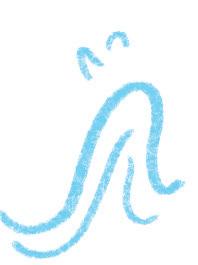






















































Email medicalct@torontomu.ca or call 416-979-5070 for support. Call 911 in all emergencies.
Ombudsperson’s Office

























































Confidential help for students who need it when dealing with the university’s systems and processes. Call 416-9795000 ext. 557450 or email ombuds@ torontomu.ca.
Student Learning










































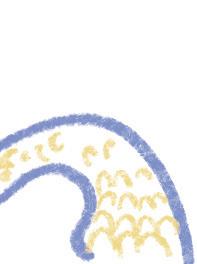




For academic support and tutors, call 416598-5978 or email slls@torontomu.ca.

For material and search help call
416-979-5055.


Academics

For academic help, questions and concerns, visit torontomu.ca/contact/student/academic_contacts.
Accommodations for students with disabilities

Email aasadmin@torontomu.ca or call 416-979-5290.

Academic appeals
Have a problem with your grades? Visit yourtmsu.ca/services/academic-advocacy.



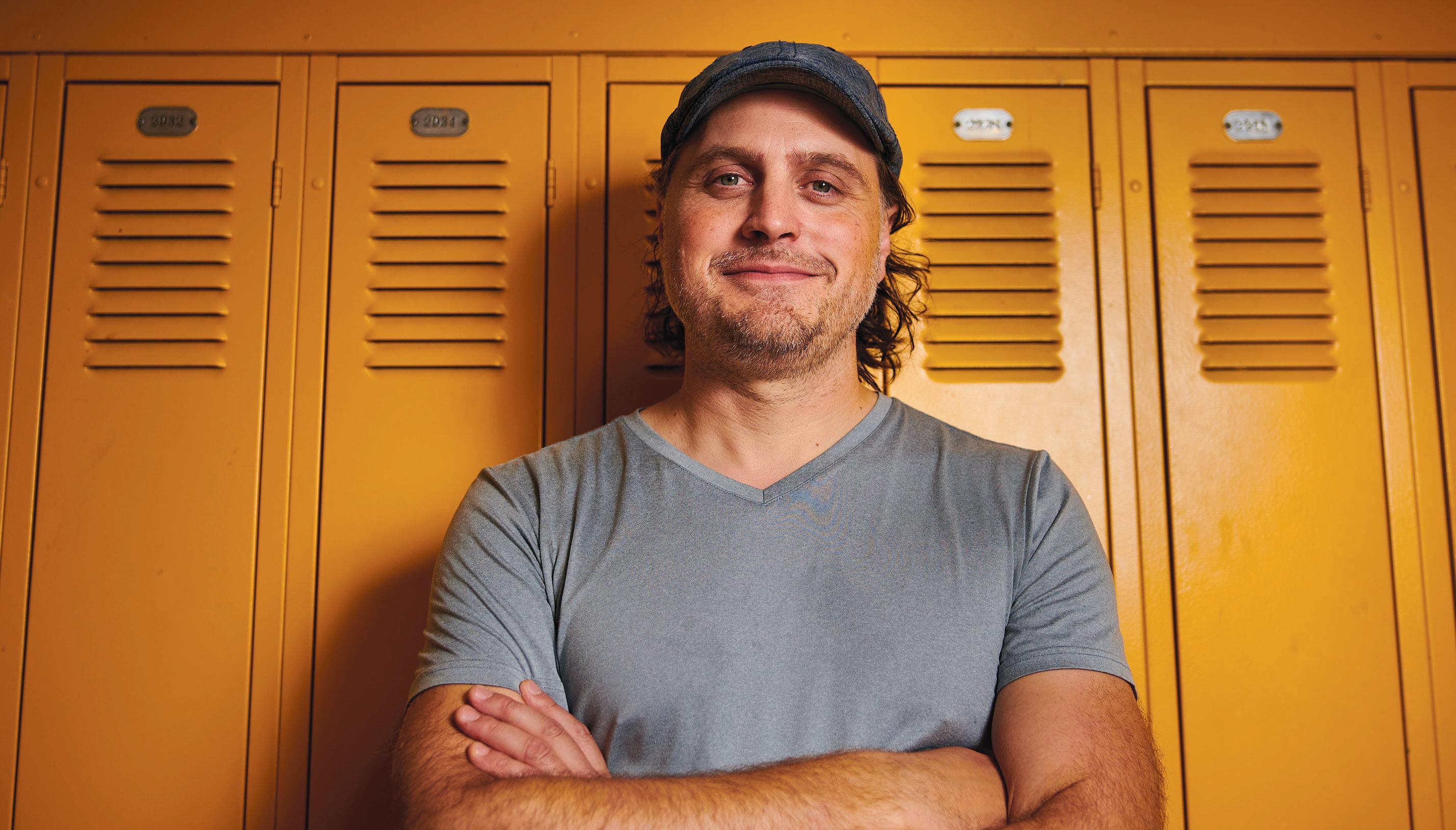
By Nalyn Tindall
When walking into a lecture hall, your mind is likely swarmed with thoughts on how to survive the semester ahead. But while you’re focused on your own survival, it’s worth considering another crucial factor: your professors. Those individuals at the front of your lecture room have their own set of pet peeves that can make or break your university experience.
It might seem like a nobrainer, but punctuality and attendance are crucial for all students. “Not attending classes is my number one,” says Toronto Metropolitan University (TMU) queer media instructor Andrea Houston. It’s simple: if you’re not there, you miss out on vital discussions, guest speakers and frankly your professor’s efforts.
“Don’t think about getting an A, think about developing your skills”
Houston stresses that, regardless of whether a course is an elective or a mandatory class, showing up is a sign of respect. She believes if you need to miss a class, avoid simply sending an email saying, “what did I miss?” Instead, take responsibility for
catching up on your own or ask your professor for guidance the best way to do so.
Your professors are not only educators but also passionate individuals invested in their fields. They exhaust a great amount of effort crafting and delivering their courses as well as carefully curating content to maximize student success.
Houston says she puts a lot of thought, time and effort into developing her classes.
TMU ethnomusicology professor Sean Bellaviti says “everything in the course is important” and encourages students not to ask what part of each lecture they need to know. Instead, he suggests students approach their studies holistically, recognizing that each component of the course contributes to their overall understanding and academic success.
“Don’t think about getting an A, think about developing your skills,” says TMU journalism professor Angela Misri. She advises students to focus on developing skills and gaining experience rather than fixating only on grades.
Misri says now is the best time to gain experience, skills and a network that will come in handy when trying to get hired down the line. Houston says, “forming good habits will mean that you probably do very well
in your career, you’ll meet the right people and end up in the right rooms.”
Bellaviti emphasizes the importance of academic integrity saying, “it’s really important that students learn what paraphrasing actually is.” Plagiarism and a lack of understanding regarding proper citation practices are significant issues that can trip students up and lead to major consequences.
“Professors are just humans, we love to be talked to”
According to a report from CBC News called “Cheating on the rise in universities and colleges” in Canada. TMU’s Policy 60 outlines the school’s academic integrity policies.
Bellaviti notes the importance of grasping the basics of academic writing and urges students not to shy away from seeking help when they’re unsure. He says it’s better to ask your professor directly if you have questions, rather than always relying on classmates for information. “I like to think I’m pretty friendly,” he adds, encouraging students to form relationships and engage directly with him.
Building a relationship with your professors can greatly enhance your learning experience.
He encourages students to form a connection and ask questions when needed. “I want students to feel like they can come and talk to me,” he says. Seeking feedback and engaging with your professors not only helps you better understand the material but also demonstrates that you’re invested in your academic growth.
“Professors are just humans, we love to be talked to,” says Misri. She values students who are enthusiastic about learning and who make an effort to engage with both the material and the class as a whole. This can be done by showing interest in the subject matter and participating actively in discussions.
One of the biggest pet peeves for many professors is disruptive behavior during class. Houston points out that packing up your belongings before the class is officially over can be very disrespectful, especially “if I’m still talking, or God forbid one of my guest speakers is still talking.” It’s crucial to stay attentive until the very end of the session. These disruptions not only affect the flow of the class but can also signal disinterest to your professor.
Professionalism isn’t only mandatory within classroom walls but extends into your interactions with professors outside working hours. Houston
advises students to be considerate in emails and other forms of communication. While inclass it’s important to engage in discussion in a respectful manner, “I love when people bring challenging arguments,” Houston notes. Still, she emphasizes that combative behavior is not acceptable. Constructive dialogue and respectful communication are key to maintaining a good rapport with your professors and instructors.
At the end of the day it’s important to pay attention and take note of what your professors say as everyone will have their own preferences. If the syllabus makes it clear cell phones aren’t welcome in class, remember not to check Instagram during that lecture—even in classes where the teacher might be fine with phone usage.
“Forming good habits will mean that you probably do very well in your career”
Ultimately, don’t be afraid to be yourself. Professors appreciate when students are authentic and approachable. Misri says it’s natural to feel nervous but it’s important to remember your professors are there to help and support you throughout your academic journey, reminding students “we’re people too.”
When Sonnet Hines made the decision to attend Toronto Metropolitan University’s (TMU) orientation week as an incoming student two years ago, she knew she had to go to as many events as she could.
Despite the uncertainty and nerves around going to orientation events, Hines’ experience made a notable impact.
“It was an absolute blast,” she said. “Everyday I’d be up from nine in the morning and come back at 11 at night.”
“My whole process was I’d look on the orientation website and I’d plan out my day because I wanted to go out for the whole day. I was booking everything into my calendar,” she said.
Now beginning her third year in the professional communications program, Hines looks back at these experiences with a smile.
“I still have friends from orientation, so there’s that lasting impact,” she said.
“The brain hears a lot about novelty and uncertainty, you may as well make it as good of an experience as possible”
According to the Student Life and Learning Support’s (SLLS) website, the goal of TMU Orientation Week is to give “the chance to connect with other students, get familiar with your academic program and get to know your way around campus.”
For the 2024–2025 school year, the fall semester’s orientation week—commonly referred to as frosh—will start from Aug. 25 to Sept. 2, while winter orientation takes place in January 2025.
Andrew Metcalfe, TMU’s orientation and campus events facilitator, said frosh is unlike any other of the school year.
“Campus has a really awesome buzz to it,” said Metcalfe. “People are excited, there’s always music playing, there’s tables set up with different campus organizations.”
However, the start of one’s university journey is not linear for all students. Karl Szpunar, an

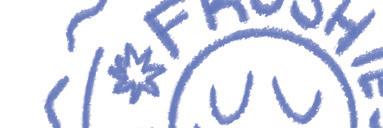
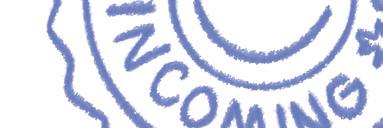
associate professor of psychology noted this start represents a “very critical change.”
“The jump we make when we go into undergrad is the beginning of a very important lifetime period that is very new,” he said. “Anything we can do to help to adjust ourselves, to help us with what we are getting into I think is a very good thing to do.”
TMU’s downtown Toronto location differs from a classic university setting and creates a modified version of frosh— raising the question of whether these events are worth it.
However, orientation has proven itself to be an effective introduction to university life.
Orientation signals the start of a new school year—which can be a transition not all students are prepared for.
Szpunar, also the director of psychological science training at TMU, identifies these transition periods as a “cultural life script.”
“When we embark on these cultural periods, because it’s so novel, you’re going to remember it,” he said. “The brain hears a lot about novelty and uncertainty, you may as well make it as good of an experience as possible.”
Metcalfe also understands how making it to orientation can be “a large barrier,” especially for commuter students.
“I understand not wanting to make the commute,” he said. “I know for a lot of our students it’s a huge burden. You are paying 12 bucks one-way on the GO train to get to campus, plus two hours of your life.”
Despite this, orientation can be more than fun music, colourful tents and free merchandise.
“I can connect with them on the same level because It feels familiar to home”
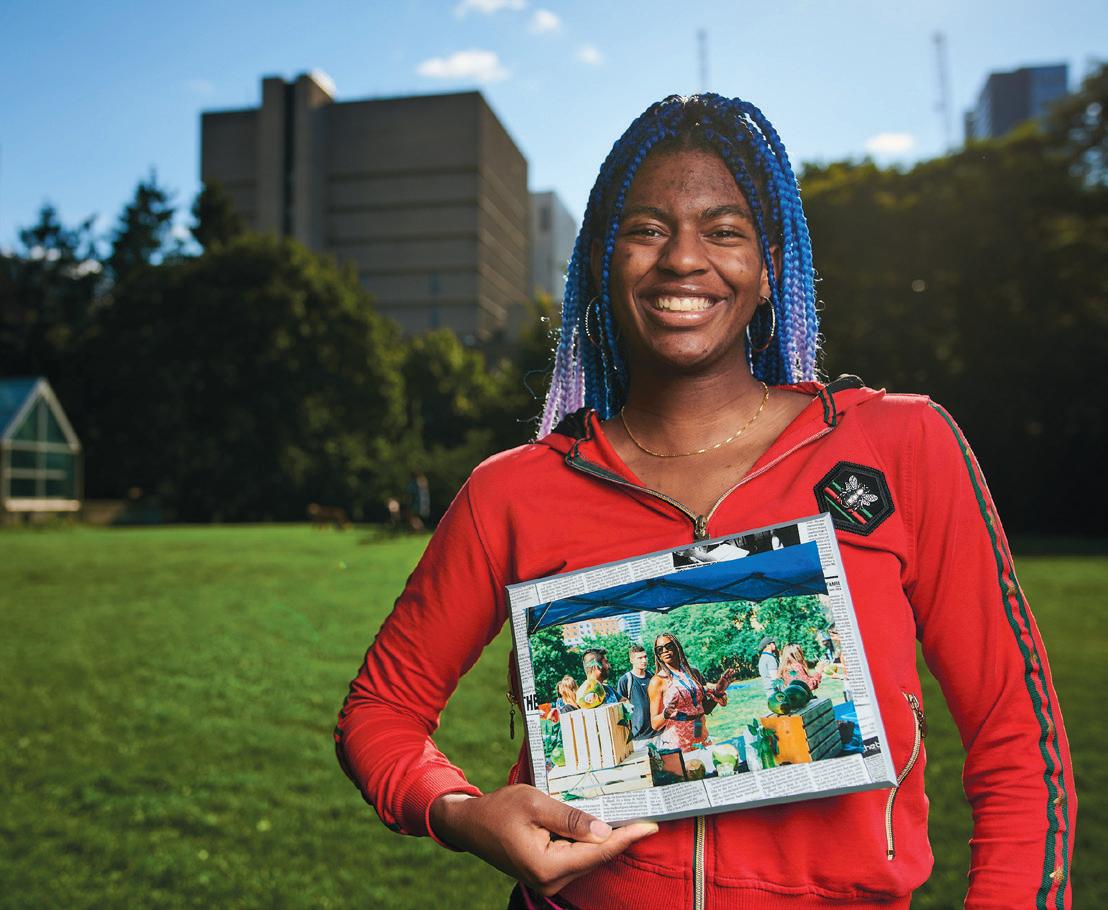
She felt this connection helped her overcome the homesickness she was feeling at the time.
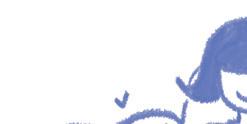
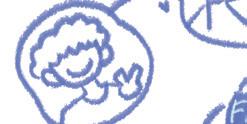


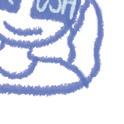
“The first thing I thought was: oh, I can connect with them on the same level because it feels familiar [to home].”
The events she attended helped to ease her into life in a new city around new people.
“Those three days of orientation were so helpful because I got to meet a lot of my floormates, people from different buildings and all the international students,” she said.
Shardha felt the connections she made helped bring her closer to the school, even if they did not stay in touch for long.
Kanakamedala only attended this orientation event in his first year. To this day, he remembers it fondly and kept the letter he wrote.
Metcalfe emphasized that orientation week can provide students the chance to “build their social networks.”
“I often find that TMU could feel lonely, where folks pack up, come to campus, do their classes and immediately come home,” he said. “It’s hard to make friends, so I find orientation week provides this really unique opportunity where you have all these people on campus together.”
“If I did not go to orientation, I don’t know if I would be the person I am today”
Not only can orientation be a vital chance to forge connections, it can also help provide career opportunities.
a
By Khushy Vashisht
On a hot summer day, the energy inside a North York chapel was buzzing and bittersweet. 17-yearold Aliza Ali looked around at the classmates she had known for years, adorned in white caps and gowns, when it suddenly started to sink in: her high school days were officially behind her.
Now, Ali is looking ahead to her first year in mechanical engineering at Toronto Metropolitan University (TMU) with both nerves and excitement.
According to peer-reviewed journal Applied Developmental Science, young adults experience crucial identity-based changes more than other age groups— including the transition from secondary to post-secondary education, which can alter one’s socializing system.
“There’s a lot of excitement and curiousity”
Ryan Persram, an assistant professor in the department of psychology at TMU, said pursuing post-secondary education can be one of the first major decisions of young adulthood.
“There’s a lot of excitement and curiosity,” said Persram. “As a 17 or 18-year-old, [you] are making a decision on what school you want to attend, what you’re going to [study] or moving away from home.”
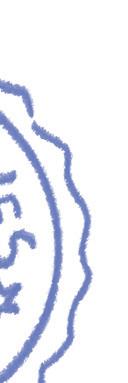


Divisha Shardha, a secondyear fashion design student, attended three days’ worth of events during her own frosh week last year. She had just arrived in Canada from Pakistan, instantly immersing herself into the university environment. She focused on attending events centred around campus housing and resources for international students. An event organized by the International Student Support (ISS) resonated with her deeply. Through it, Shardha learned that several students there were not only living in the same building as her but on the same floor.
“This was my first time travelling alone...the first few weeks were very overwhelming but getting to meet new people and finding them from your home country, neighbouring countries or even just a sweet person, it felt quite good,” said Shardha.
While first-years take part in activities planned for them, older students help to facilitate and run events during this time.
Ram Kanakamedala, a thirdyear computer science student and current orientation events lead for ISS, takes pride in facilitating events for students in a similar position as he once was as a first-year.
One event he helps prepare is called “From Toronto, With Love: Undergrad & Grad,” where students write letters to their families and mail them back home.
Isha Sidhu, a third-year business management student, attended various residencybased events, the Ted Rogers School Orientation Commerce Frosh and more before starting her first year.
The following year, she volunteered at frosh and in May 2024, she joined the SLLS team as an orientation crew lead, saying it “blows my mind everyday.”
When looking back at her first year, Hines believes her orientation experience had a long-term impact on herself.
“Orientation week was one of the many opportunities where I could be myself and show my positive energy,” she said. “That was the beginning of my growth as a student at TMU, because if I did not go to orientation, I don’t know if I would be the person I am today.”
Ali decided to study at TMU following a high school university fair. She liked the co-op opportunities the school offered but the diverse student body was a deciding factor.
“I really love my culture and sometimes it’s very upsetting when there’s people around you that aren’t from that [culture], you feel you don’t fit in as much,” she explained. “It’s honestly great to have representation on campus because you never feel alone.”
Mia Greenidge, a first-year RTA media production student, will attend TMU following a gap year she took after graduating high school. She said the change in routine makes her “a bit nervous to readjust.”
An even greater change in her routine will be location altogether as she will be moving to Toronto from California.
Read more at theeyeopener.com
By Ria Sidhu
Aaron Rhooms did not have much of an off-season.
Instead of a break from his sport, the Toronto Metropolitan University (TMU) Bold men’s basketball guard spent his summer in Edmonton playing in the Canadian Elite Basketball League (CEBL) with the Edmonton Stingers. After being drafted fifth overall in the CEBL-U Sports draft, Rhooms hit the court in 10 of the Stingers’ 20 games from May up until a Western Conference semifinal loss to the Calgary Surge on Aug. 4.
Rhooms said the CEBL experience was the highlight of his summer, not just for the oncourt growth but also the opportunity to explore Edmonton, enjoy it’s natural beauty and appreciate how much basketball is loved across Canada.
“I didn’t know how important basketball was out there until I got there,” he said. “The love that we got as players…just walking around Edmonton... people know the Stingers.”
Rhooms’ summer is a sample of the way TMU athletes stay active in their sports during the off-season. Whether honing their skills in professional leagues, coaching the next generation or balancing multiple jobs, the summer presents these athletes with a rare opportunity to step away from the intense demands of being a student athlete and focus on themselves and their passions.
“I get to pick the brains of older guys and players who have more years of experience”
Christina Karaiskakis, a thirdyear business management student entering her second year on the TMU track and field team, has been training and competing with the Toronto-based Blue Devils
Athletic Club throughout the summer. The Blue Devils, operated by TMU track and field assistant coach Tristan Markov, have also given her the opportunity to keep in touch with her teammates during the Ontario University Athletics (OUA) off-season.
With only a short break between the indoor and outdoor track seasons, Karaiskakis has remained focused on improving her strength and staying in tune with her body.
“I see the progression I’ve made from when I first started in the indoor season to my first outdoor season. It’s honestly a mental game for me because it’s such an individual sport … at the end of the day, you’re the only person running your race,” said Karaiskakis.
She said she is proud of her productive summer and reflects on her athletic improvements since she started running competitively about a year ago. As a result, she’s found that being able to train and race throughout the summer has kept her fit and motivated.
“One thing I love to go by is ‘if you believe it, you can achieve it’ because if you don’t believe in yourself, you’re not going to set the goals you want and you’re not going to achieve them,” she said.
In the summer, just like during the school year, she balances classes, working part-time and training multiple days a week.
“I know it can be a lot but I know I have that time management. I know I can do it,” she said.
For other TMU athletes, the off-season means returning home to decompress from their academic lives and spending time with their families. While training and keeping healthy remains important, the off-season allows them to explore other passions beyond the court, track or arena.
Riley Donovan, a third-year outside hitter on the TMU men’s volleyball team, returned
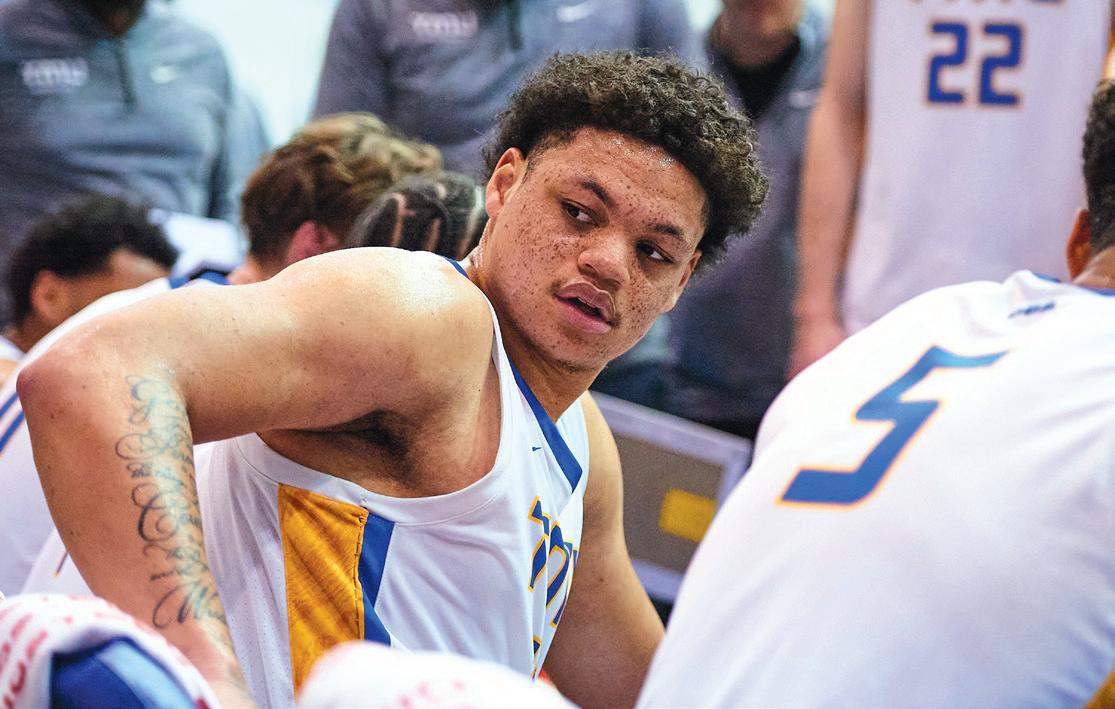
home to Sydney, Australia this summer after wrapping up exams in April. Since then, Donovan has been coaching volleyball and travelled to Canberra, Australia for a few days to train with a national senior men’s team camp.
Donovan said he’s enjoyed staying active by playing golf and beach volleyball with friends during his break.
“I’ve definitely found time to catch up with friends I hadn’t seen since I left for Canada and hung out with my family as well…I don’t see them a whole lot so it’s been good to really take the time and just be around them,“ he said.
“The busyness kind of never stops”
Donovan has found the slowpaced environment at home to be a refreshing change from his busy school year. Being around the support of his family while taking on fewer responsibilities has given him the chance to recharge before the upcoming season. Up until mid-July, he was focused on training with the state of New South Wales before heading to the U23 nationals in Adelaide, Australia where they won gold.
“It was really cool to be a part of a team that had a lot of fun off the court, then on the court we would play focused, which was pretty similar to the TMU team,” said Donovan.
With a gold medal in hand, he said he looks forward to getting back into the gym and reconnecting with his teammates to work on tactical strategies ahead of the season.
While some athletes travel back home, others like Karaiskakis and Bold women’s soccer players Amy MacLellan and Elisa Paolucci remain in Toronto and found a way to play their sport during the break.
MacLellan, a fourth-year defender, and Paolucci, a secondyear goalkeeper, have spent their summer playing for Scrosoppi FC, a League 1 soccer club based in Milton, Ont. The team is managed by TMU lead assistant coach John Yacou.
Paolucci mentioned how many TMU women’s soccer players finished the OUA season and went straight to play for Scrosoppi FC. She said along with soccer and a trip to Portugal, her summer included lots of hanging out with teammates.
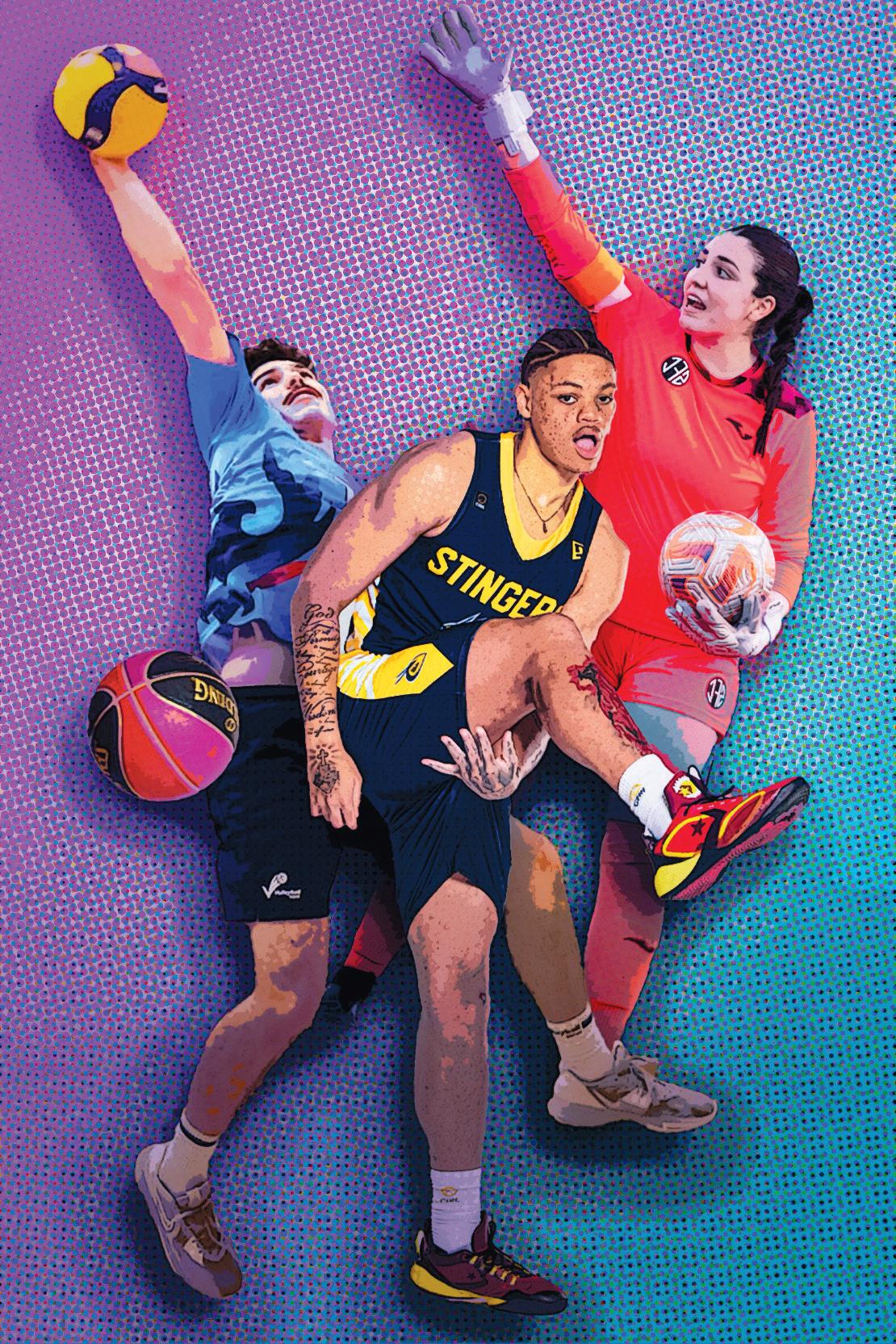
“We’re never apart. We’re super close,” Paolucci said.
Living in Etobicoke, Ont., she practices three to four times a week with additional private goalkeeper training and regular workouts to stay fit for the upcoming OUA season. In her limited free time, Paolucci even coaches U11 girls’ soccer.
“The busyness kind of never stops,” she said.
MacLellan has spent her summer competing with Scrosoppi FC while bouncing back and forth between Mississauga, Ont. and Toronto trying to balance lifeguarding, training and working at SickKids hospital.
“I would say my focus is more health, work and athletics in the summer,” she said.
Despite her busy schedule, she found time to be more serious about golfing and has enjoyed the chance to explore new courses.
“I’ve
definitely found some time to catch up with friends I hadn’t seen since I left for Canada”
Ultimately, the off-season is a time of growth and preparation for TMU athletes. It provides them all with an opportunity to recharge, reflect and set new goals for their upcoming seasons. Rhooms’ summer epitomizes this as he put his focus
towards making the most of the CEBL experience.
Though he played for the Scarborough Shooting Stars in the CEBL in 2023 and knew what he was up against in the professional league, it was a competitive challenge that kept him ready for the OUA season.
“When I was around in Edmonton, or any part of the CEBL, [I was] playing with pro players. These are guys that either have NBA experience, NBA G League experience or overseas experience, so you get a different caliber of play,” said Rhooms.
For Rhooms, the CEBL features faster games, stronger players and more strategic gameplay than the OUA. He found the exposure particularly valuable for his development as he had the chance to learn from experienced players like Jacob Evans III, who played with the Golden State Warriors during their 2018 championship run.
“That’s a benefit for someone like me who’s still in [university]. I get to pick the brains of older guys and players who have more years of experience,” he said, adding that the higher level of play helps on and off the court.
“Being around professionals and seeing the way they act… showing a different passion towards their craft, I think that’s something that I can bring back to the team.”
By Anthony Lippa-Hardy
Due to high production costs and increased inflation on school resources, university students are now faced with an added financial burden as textbook prices continue to soar.
According to the Toronto Metropolitan University (TMU) tuition and fees webpage, depending on the program of study, students can expect to pay anywhere from $1,400 to $9,400 for textbooks and school supplies in addition to their tuition and housing fees.
Alessandro Balsamo, a fifthyear business management student at TMU, said the heightened cost of textbooks acts as an added financial hardship.
“I live alone downtown, so it affects me a great deal,” he said.
Balsamo spends roughly $400 per semester on required textbooks for his program. He said this money could be better spent on other, more essential life expenses.
“If you think about it, one person living alone—$400 worth of groceries could probably last me two months,” said Balsamo.
He said providing more access to open educational resources would be beneficial for students since there have been times when he hasn’t purchased textbooks due to the high prices.
One of the major factors contributing to high textbook prices is the production cost of the book itself.
Art Seto, a professor of graphic communications management at TMU, said the process of printing and binding books are “a quarter of the cost,” to create them.
He specializes in bookbinding and explained that there are four main types of bookbinding processes: saddle stitching, perfect binding, mechanical binding and case binding. These processes range in price and production complexity, with saddle stitching being the least expensive and case binding being the most.
Each process has its own set of pros and cons but out of these four, Seto said only case binding has the durability required for a textbook.
“Glue adhesive spines don’t last forever, whereas [casebound] books can last 500 to 600 years,” said Seto. He explained that sewing the pages together in the case-bound process as opposed to gluing them makes the book considerably more durable.

Seto emphasized the importance of durability in reusable academic resources. Hardcover case-bound books are the only viable option for textbooks seeking longevity and maintaining market value, he added.
However, this added robustness also increases costs for casebound textbooks, mainly due to the additional steps involved in creating the hardcover books.
“You’re going to use 10 or 15 different machines to make a hardcover book”
He explained the extra steps don’t just mean more man power—they also require more real estate and utility charges, all of which add to higher overhead costs for printing companies.
Inflation has also played a significant role in higher textbook prices. According to Ana Ferrer, an economics professor and associate dean at the University of Waterloo, “a lot of the increase [people have] seen in prices recently has to do with inflation.”
Since this February, the recreation, education and reading category of Canada’s Consumer Price Index has increased by 2.6 percentage points, according to Statistics Canada, indicating inflation on academic resources has risen over the past seven months.
According to Ferrer, rising labour and material costs also impact the final cost of textbooks.
“Labour is more expensive, a lot of materials are more expensive and technology is more expensive. Everything is going to hike up those prices,” she said.
Along with rising prices, McGraw Hill, one of the leading publishing companies behind Canadian textbooks, saw an increase in profit amidst high inflation rates.
This past quarter, McGraw Hill reported billing their customers $85 million while also hitting a record share increase of 27.6 per cent.
This comes with a 25 per cent year-over-year increase in inclusive access sales to over 1,800 campuses. Inclusive access sales are textbook sales that are pre-built into students’ tuition. This means students who are forced to pay for this service can’t experiment with cheaper online or pre-owned textbook options as they have already paid for the material.
Given the high textbook fees, some students have turned to pirated websites to access copyrighted class material.
“This past semester, there was a textbook that was like $300 [so] I just got one off a pirated website,” said Balsamo.
Sites like PDF Drive and Libgen.is offer free textbook down-
LEBRON PRYCE/THE EYEOPENER
loads without copyright permission from the original owners of the work.
Kwame Ansong, a third-year computer science student at TMU, said he uses online resources for classes outside of his major that are not specific to his degree.
“For the art courses, I don’t always find it necessary to buy a physical textbook,” he said.
Ansong doesn’t see anything wrong with using online books if they weren’t written by the professor teaching the material. However, half of the challenge for him is finding the right online resources.
“There are already so many tools available online. I just think knowledge about them can be improved”
Ansong uses tools like Google Scholar and a variety of PDF download websites to find online textbooks for his courses.
He would like to see more professors promote free online textbook services since students are already using them and it would provide additional financial support.
Ansong and Balsamo aren’t the only ones who see online textbooks as the future. Ferrer also agrees there may be a shift from traditional tangible textbooks to alternative services.
“What we may see—and I don’t know how fast this will come about—is a switch from traditional textbooks to other sources,” she said.
The Government of Ontario is also striving to make university textbooks more affordable through the Ontario Open Textbooks Initiative. In 2017, the province invested $1 million into the program designed to get copyrighted online textbooks into the hands of university students across Ontario.
In a 2017 press release, the Minister of Advanced Education and Skills Development, Deb Matthews, said “by supporting a movement of free online textbooks and other open educational resources, we are removing yet another financial barrier to accessing post-secondary education in Ontario.” Currently, the program provides access to over 180 open source textbooks, which are available on the eCampusOntario website.
A similar initiative has been established in British Columbia and has saved learners over $4 million, according to the province.
Unfortunately, for university students across Canada, the high costs of tangible textbooks shows no signs of decreasing. Statistics Canada continues to report higher-than-average inflation on these academic resources spanning over the last three decades.
Hope you’re a fan of green, you’ll be seeing a lot of it soon
By Sarah Grishpul
Disclaimer: Unlike the Kamala Harris presidential “brat” campaign, this article is a work of fiction.
Toronto Metropolitan University (TMU) president Mohamed Lachemi recently announced that the campus will undergo extended renovations as part of the school’s new “brat” campaign just before orientation begins.
“I am proud to announce that after completing the ‘How Brat Are You Actually’ Buzzfeed quiz, our institution is officially brat certified,” said Lachemi on TMU’s public X account.
The university hinted at this news in early August, changing their social media accounts to match the Charli xcx album cover brat and @yaboipresidentlachemi posting “tmu IS brat” on his personal X account.
Sources close to The Eyeopener reported the president was even seen on campus wearing a bright green cropped tee, chunky boots with a two-inch heel and a pair of Balenciaga
Wraparound Sunglasses. He spent the day partying with students, whispering “I’m so Julia” under his breath and filming TikTok videos of the “Apple” dance with local influencer Frankie the Falcon.
The concept of “brat” derives from singer-songwriter Charli xcx’s latest album targeted at the girlies—ready to party and embrace being unapologetically themselves.
According to Lachemi, brat is being doused by steam from the sewer gates on the way to class. brat is being 10 minutes behind but never being late to class. brat is using flex dollars to go drinking at The Met Campus Pub.
The proposed campus makeover will include dyeing the water in Lake Devo green, removing all capital letters from signage and changing all sports team names from TMU Bold to TMU brats.
Second-year RTA media production student and fervent Charli xcx stan Kathya Rabbinovich is excited to see the university take this new direction.

“I don’t have to feel embarrassed anymore that there’s sometimes pee on the sidewalk or the air smells like burnt plastic,” she said. “Instead I can say: ‘that’s so brat.’”
Since the announcement, the university has set up a GoFundMe page to raise money for green paint and legal fees.
“Last year’s renovation project and binge-watching The Property Brothers has taught me that change ain’t cheap,” Lachemi said. “They charged us by letter and becoming ‘Toronto Metropolitan University’ ended up costing around six million dollars.”
The president has been put-
ting his social media prowess to work to seek a public financial endorsement from Charli xcx. He is engaging in guerrilla marketing tactics like “sliding into her DMs” and picking fights on the official brat subreddit. Charli xcx and her management team have yet to respond for comment.
Gain an exclusive sneak peek of all of the hottest crannies and crevices on campus
By Ella Miller
So, you want the real scoop?
Gather around, my “frosh” meat. Toronto Metropolitan University (TMU) boasts a labyrinthian campus spanning the entirety of Toronto’s downtown core. There are definitely some places and attractions you might have missed while being shepherded from place to place by an underpaid student guide. Fear not sheeple, this seasoned spelunker is here to free you from the Lachemisanctioned shackles.

Heed my warning, the Kerr Hall Dungeon—title pending approval—is not for the faint of heart. This place has everything: abandoned furniture, dead-end hallways and a stage where Frankie the Falcon will perform stand-up comedy in exchange for flex dollars. If you listen closely, you can still hear the tortured screams of financial mathematics students sacrificed by their peers in exchange for an understanding of the stochastic process.
If the evil dungeon isn’t entirely your speed then check out the benevolent Lake Devo Wooden Structure. What’s in it for you? In the winter months, it serves as the occasional skate rental stand. In the warmer months, it’s an Airbnb for summer school exchange students. So Muskoka-core, n’est pas? Fun fact for horror fans, this is actually where they filmed Evil Dead 2. The Necronomicon was really an old textbook from the bowels of the TMU library.
Across from the Student Campus Centre, you may catch a whiff of the Gould Street Dumpster. Wafting its foul juices into the front lawn of Oakham House, this dumpster is part of the campus’ trashy-chic ambience. The engineering department is currently working on a perfume of its signature scent. The eau de rat corpse and Pitman Dining Hall slop will be sold in the campus store this holiday season.
A civil war is brewing on campus inside the unsuspecting Sally Horsfall Eaton Centre. Certain floors of this compound are forbidden to average TMU students in favour of George Brown College students. It’s about time we figure out what they’re up to and when they’ll strike next. So far all of our espionage efforts have been foiled but that will change once our comrades come out of deep cover. Fly my monkeys! Fly!
To the north of campus, you will find the sprawling Mattamy Athletic Centre, the former home of the Toronto Maple Leafs and current home of a Loblaws. Throughout the facility, you’ll discover mementos to the past, including an old stadium chair mounted to the wall. If the legends are to be believed, then whomever sits upon the wall throne will be crowned the next King of TMU—could it be you?